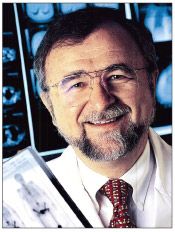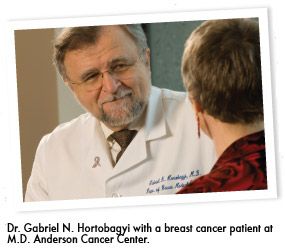The long and winding road to Houston
Gabriel N. Hortobagyi, MD, was born in Hungary to a mother who had wanted to be physician. “It was a time and place in which medicine was not a suitable profession for a woman, yet I think my mother’s subliminal messages worked on me,” he said in an interview with Oncology News International.
HOUSTON-Gabriel N. Hortobagyi, MD, was born in Hungary to a mother who had wanted to be physician. “It was a time and place in which medicine was not a suitable profession for a woman, yet I think my mother’s subliminal messages worked on me,” he said in an interview with Oncology News International.

Dr. Hortobagyi grew up in Hungary in the iron-clad grip of Cold War communism. He said that during his childhood he was an avid reader, enthralled by science and medical books in particular.
“I can’t pinpoint when it became a conscious decision, but as far back as I remember, I always wanted to be a doctor,” he said.
He spoke to ONI from his office at The University of Texas M.D. Anderson Cancer Center, where he is professor of medicine, chairman of the Department of Breast Medical Oncology, and director of the Multidisciplinary Breast Cancer Research Program.
Post-war Hungary was an inhospitable environment for people like the Hortobagyis, college-educated intellectuals, who were maligned by the communist machine that swallowed Hungary with its tanks and guns and ideology.
“We were on the wrong side of the political equation. The regime placed us in an internal concentration camp, doing forced labor for about 3 years,” Dr. Hortobagyi said.
When Stalin died in 1953, the Hortobagyis were released from the work camp, but not from the heavy shadow of communism.
“The government still considered us undesirables in our own country. We were forbidden to live in Budapest, the capital, and my parents were limited to menial employment,” he said.
The government’s active suppression of the Hortobagyis illustrated a bitter irony.
“Although the communist regime prided itself on universal education, my two sisters and I were not allowed to complete our high school education,” he said.
Crossing the border
These grim circumstances finally exploded into the streets. Amidst the chaos of the 1956 uprising, the Hortobagyis escaped across the boarder to Austria. After a few months in Vienna, Dr. Hortobagyi’s erudite father struck up a friendship with a Colombian ambassador who helped them secure political refugee status. Another adventure waited as the family set sail for Bogot, Colombia.

“At that time, Bogot was a sleepy, tropical city. People were polite and cultured. That was before the drug cartels and their bloody wars,” he said.
Back at school, he dived headlong into his studies, eventually earning his medical degree from the Universidad Nacional de Colombia, graduating at the top of his class.
“I wanted to be a surgeon, but in Colombia you’re mandated to practice for 1 year in an underserved community before getting an unrestricted license,” Dr. Hortobagyi said.
In the trenches
He was sent to the 100-bed hospital that served Pacho, a small village that seemed to grow out of the western slopes of the central branch of the Andean mountains.
“I was the director, the intern, and the head of pharmacy, gynecological services, cardiology, and emergency services. I was even the pathologist, doing autopsies. My only relief was a part-time retiree who helped out with pediatrics,” he said.
Carved into the other side of the mountain was the country’s largest emerald mine. There was little law to speak of. Shootouts and knifings among roving gangs of emerald smugglers provided a steady stream of patients to patch up.
“I wanted to be a surgeon, and there, at Pacho, I was. But I actually got more than I bargained for, and under somewhat primitive conditions,” he said.
He ran the hospital with three nuns and a few locals with no medical training. “The community depended on me, no one else,” he said. “And I had to perform.”
There was no ivory tower, no science to hide behind. He was 24 years old.
On to the United States
The weight of his experience in Pacho shaped him as a doctor. And while doctoring in the trenches gave him his foundation, he knew he had to move on. There were too many questions that needed answers.
After his tenure in Pacho, Dr. Hortobagyi went to the United States, took the necessary exams, and did his internal medicine residency at St. Luke’s Hospital in Cleveland.
“My boss was an endocrinologist. He took me into the lab, and I learned some of the rudiments of research and scientific method,” Dr. Hortobagyi said.
An encounter with breast cancer
During his second year while doing rounds, he encountered two young women with extensive metastatic breast cancer to the bone. At that time, oncology was not a defined specialty; it was more a matter of interest.
“I’d read an abstract that claimed chemotherapy could give symptomatic relief in a large fraction of metastatic patients, and I became fascinated with that possibility,” Dr. Hortobagyi said.
However, his attending physician didn’t share his enthusiasm for the radical concept, forbidding him to give these patients “poison when they’re going to die anyway.”
But Dr. Hortobagyi decided not to accept a directive that he intuitively felt was wrong. In his mind, this was a beginning, an exploration of medical possibilities.
“In blatant contradiction to my orders,” he said, “I prescribed chemotherapy for the two women. Fortunately, by the time my insubordination was discovered, the women had responded, at least symptomatically, and were discharged.”
Referring to his insubordination, Dr. Hortobagyi said, “I had my knuckles rapped, and was raked over the hot coals. But, more important, I’d caught the bug; I was obsessed. I wanted to know why cancer behaved the way it did, and why we were unable to treat it successfully.”

The path is set
Searching for direction, he went to a one-day American Cancer Society symposium in Ohio, which, not surprisingly for the time, gave short shrift to solid tumors. But a lecture by Dr. Emil Freireich energized Dr. Hortobagyi’s percolating interest in oncology.
“Cancer was spoken of in whispers then, even by physicians, because it underlined our impotence, but Freireich was upbeat, optimistic, talking about scientific advances that were making inroads in cancer treatment. It was a fascinating talk,” he said.
After hearing Freireich, his career path was set, and he applied to several institutions, but he said he always knew he would end up at M.D. Anderson Cancer Center.
Dr. Hortobagyi’s impression of Texas had been informed by John Wayne movies; it was one big roaring gunfight, a place that drew its side-arms at high noon. Instead, the young doctor discovered an exciting landscape with a can-do attitude that fit him like a tailored suit.
“On my first day at M.D. Anderson, I went up to the chief of breast services and announced I was going to do research in breast cancer and I needed him to make room for me,” Dr. Hortobagyi said.
The chief gave him a “who-the-hell-are-you” look, and then very graciously accepted him into the fellowship program. It was, of course, a wise decision.
Landmark publications
In the subsequent years of his early career, Dr. Hortobagyi conducted what is now considered a landmark study in preoperative chemotherapy to reduce the size of large, nonmetastatic breast tumors.
In 1988, he published a 10-year study showing that a three-drug regimen given before surgery, with radiation therapy after surgery, produced promising results for breast cancer patients with advanced disease.
Other research from Dr. Hortobagyi that has generated standard-bearing practices in breast cancer management includes the use of bisphosphonates for patients with bone metastases and the introduction of paclitaxel and docetaxel [Taxotere] in the management of metastatic and primary breast cancer.
Dr. Hortobagyi has also served the research community extensively with his presence on boards and committees, and was president of ASCO in 2006-2007.
His accomplishments fill volumes in the literature, with more than 750 full-length publications about breast cancer research. His current wide-ranging interests include molecularly targeted treatments for breast cancer, mechanisms of drug resistance, and gene therapy for breast cancer.
Along with his research, Dr. Hortobagyi has continued as a practicing oncologist. As his friend and colleague, ONI board member Nora Janjan, MD, said, “Gabriel Hortobagyi faced challenges and loss while fleeing brutal oppression in his youth, in the process, becoming a stronger, more determined, and more compassionate advocate for patients fighting a different oppressor-cancer.
Newsletter
Stay up to date on recent advances in the multidisciplinary approach to cancer.